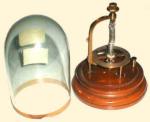

 Menu
Menu
|
Function Measurement of the temperature. |

| ||
|
|||
|
Description It is a mercury thermometer placed inside a glass cap that has a spherical shape of 55 mm diameter around the bulb. We presume the bulb to be vacuum. For this the heat arrives to the bulb in form of radiant energy. | |||
|
Function Measurement of the temperature. |

| ||
|
|||
|
Description The device is formed by a ribbon of very thin platinum gold and silver sheets, superimposed and pressed. The ribbon is wrapped in a helical form and fixed above a brass support. A container with mercury linked to a binding post is on the basis. Another binding post is placed at half height of the support of the spiral. The ensemble rests on a wooden basis and it is protected by a bell jar. The operation is based on the different expansions of the metals. If we place silver, that is more expansible, inside, the helix unwinds when the temperature increases and it rewinds when the temperature decreases. The contrary happens if we have platinum inside the helix. Gold, that has an intermediate expansion coefficient, is used to avoid breaks. | |||
|
Function Measure of the humidity of the air. |

| ||
|
|||
|
Description Two identical thermometers divided in fifths or tenths of grade are applied to a support. One of the thermometers is kept dry and the other is continuously humidified by a thin muslin or cotton wool covering, that falls into a glass underneath. When it is invested by a current of air generated by a ventilator the adiabatic cooling of the bulb of the second thermometer is in function of the quantity of evaporated air and of the hygrometric state of the air of the room at the moment of the experiment. | |||
|
Function To study the conductivity of solids. |

| ||
|
|||
|
Description The prismatic brass box is supported by four feet. In the upper part there is a hole where to put the thermometer. On the front and the back sides four bars of different materials with the same section (iron, copper, silver, lead, glass, sulphur), are placed and covered with a white film wax. Under the box the heater must placed. The quantity of melted wax on every bar depends on its conductibility. | |||